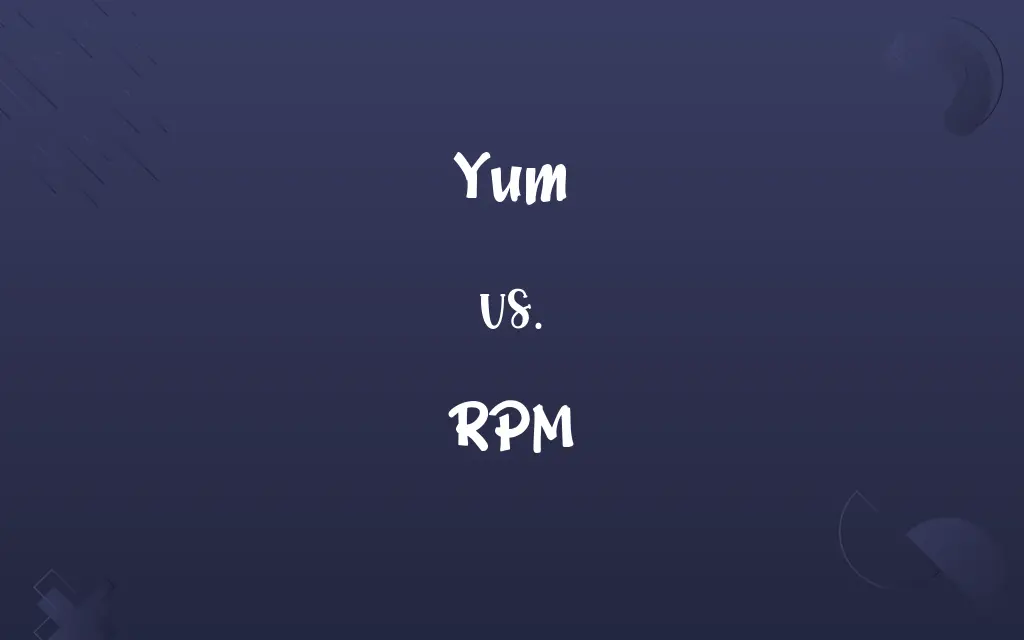Yum vs. RPM: Know the Difference

By Shumaila Saeed || Published on August 4, 2024
Yum manages software installation and updates on RPM-based systems; RPM is a package manager that installs, updates, and removes packages in those systems.

Key Differences
Yum, short for Yellowdog Updater, Modified, is a high-level package management tool for RPM-based Linux distributions. It automates the process of installing, updating, and removing packages. RPM, or Red Hat Package Manager, is a lower-level tool that handles the installation, updating, and removal of individual software packages.
Shumaila Saeed
Aug 04, 2024
Yum works by resolving dependencies and retrieving packages from repositories, simplifying the installation process for users. RPM, on the other hand, operates at a more granular level, allowing users to work with individual package files but requiring manual dependency management.
Shumaila Saeed
Aug 04, 2024
Yum is often preferred for its user-friendly interface and automated processes, which are particularly beneficial for managing multiple packages and dependencies. RPM provides more control and precision for package management but can be more complex and time-consuming for users.
Shumaila Saeed
Aug 04, 2024
Yum uses RPM as its backend for managing individual packages, essentially serving as a more advanced interface for RPM's capabilities. While RPM directly handles the .rpm files, Yum focuses on higher-level operations like repository management and automatic updates.
Shumaila Saeed
Aug 04, 2024
In terms of functionality, Yum offers features like history, rollback, and automatic updates that are not natively available in RPM. RPM is more focused on the basic tasks of package installation, upgrade, and removal, with less emphasis on overall system management.
Shumaila Saeed
Aug 04, 2024
ADVERTISEMENT
Comparison Chart
Functionality Level
High-level package management
Low-level package management
Shumaila Saeed
Aug 04, 2024
Dependency Management
Automatic dependency resolution
Manual dependency handling
Shumaila Saeed
Aug 04, 2024
User Interface
User-friendly, automated processes
More control, requires more user intervention
Shumaila Saeed
Aug 04, 2024
Operations Focus
Repository management, automated updates
Individual package file management
Shumaila Saeed
Aug 04, 2024
Additional Features
Offers history, rollback, automatic updates
Primarily for installing, updating, removing packages
Shumaila Saeed
Aug 04, 2024
ADVERTISEMENT
Yum and RPM Definitions
Yum
Yum provides a user-friendly interface for managing software.
Updating all installed packages on your system is as simple as running 'yum update'.
Shumaila Saeed
Jan 17, 2024
RPM
RPM is a package management system for installing, updating, and removing software.
To install a new software package, use the 'rpm -i package.rpm' command.
Shumaila Saeed
Jan 17, 2024
Yum
Yum is a package manager for RPM-based Linux distributions.
To install new software on Fedora, you can use Yum for an easy installation process.
Shumaila Saeed
Jan 17, 2024
RPM
RPM requires manual management of software dependencies.
When installing a package with RPM, you might need to resolve dependencies yourself.
Shumaila Saeed
Jan 17, 2024
Yum
Yum can roll back updates and manage package histories.
If a new update causes issues, Yum can revert the package to a previous version.
Shumaila Saeed
Jan 17, 2024
ADVERTISEMENT
RPM
RPM is integral to systems like Fedora and CentOS.
RPM is a core component of the Fedora package management system.
Shumaila Saeed
Jan 17, 2024
Yum
Yum automatically resolves dependencies for software packages.
When installing a complex application, Yum handles all the required dependencies seamlessly.
Shumaila Saeed
Jan 17, 2024
RPM
RPM works with .rpm package files in Linux distributions.
Downloading a .rpm file for software can be manually installed using RPM.
Shumaila Saeed
Jan 17, 2024
Yum
Yum accesses a network of repositories for software installation.
To get the latest version of a program, Yum searches through its configured repositories.
Shumaila Saeed
Jan 17, 2024
RPM
RPM provides detailed information about installed packages.
Use 'rpm -qi package_name' to view detailed information about a specific package.
Shumaila Saeed
Jan 17, 2024
Yum
Used to express appreciation of or eagerness for a tasty food or beverage.
Shumaila Saeed
Jan 17, 2024
Yum
Used to express appreciation for something attractive or to express eagerness for a pleasurable experience.
Shumaila Saeed
Jan 17, 2024
Repeatedly Asked Queries
How does Yum handle dependencies?
Yum automatically resolves and manages dependencies for software packages.
Shumaila Saeed
Aug 04, 2024
Can Yum roll back updates?
Yes, Yum can roll back updates and manage package histories.
Shumaila Saeed
Aug 04, 2024
Does Yum work with repositories?
Yes, Yum accesses and manages packages from multiple repositories.
Shumaila Saeed
Aug 04, 2024
How does RPM manage dependencies?
RPM requires manual management of dependencies.
Shumaila Saeed
Aug 04, 2024
Can RPM handle .rpm files directly?
Yes, RPM works directly with .rpm package files.
Shumaila Saeed
Aug 04, 2024
What is Yum primarily used for?
Yum is used for automated software installation and updates on RPM-based systems.
Shumaila Saeed
Aug 04, 2024
Can RPM provide package history?
RPM provides detailed information about packages but not a comprehensive history like Yum.
Shumaila Saeed
Aug 04, 2024
Is Yum user-friendly?
Yum is designed to be user-friendly, with automated processes and a simple interface.
Shumaila Saeed
Aug 04, 2024
Is Yum available on all Linux distributions?
Yum is primarily available on RPM-based Linux distributions.
Shumaila Saeed
Aug 04, 2024
Can RPM be used for software installation on Debian systems?
No, RPM is specifically for RPM-based systems, and Debian uses a different package format.
Shumaila Saeed
Aug 04, 2024
Does Yum replace RPM?
No, Yum works on top of RPM, enhancing its capabilities with additional features.
Shumaila Saeed
Aug 04, 2024
How does Yum update software?
Yum updates software by retrieving the latest packages from its configured repositories.
Shumaila Saeed
Aug 04, 2024
Can RPM and Yum be used together?
Yes, Yum uses RPM as its backend for managing packages, so they work together seamlessly.
Shumaila Saeed
Aug 04, 2024
What is RPM's primary function?
RPM handles the installation, update, and removal of software packages.
Shumaila Saeed
Aug 04, 2024
Does Yum require internet access?
Yum typically requires internet access to download packages from repositories.
Shumaila Saeed
Aug 04, 2024
Is RPM integral to certain Linux distributions?
Yes, RPM is a core component of Linux distributions like Fedora and CentOS.
Shumaila Saeed
Aug 04, 2024
Are there alternatives to Yum and RPM?
Yes, there are other package managers like DNF, APT, and Zypper.
Shumaila Saeed
Aug 04, 2024
Can RPM handle automatic updates?
No, RPM does not handle automatic updates; it focuses on individual package management.
Shumaila Saeed
Aug 04, 2024
Is Yum suitable for beginners?
Yes, Yum is suitable for beginners due to its automated and user-friendly nature.
Shumaila Saeed
Aug 04, 2024
Share this page
Link for your blog / website
HTML
Link to share via messenger
About Author
Written by
Shumaila SaeedShumaila Saeed, an expert content creator with 6 years of experience, specializes in distilling complex topics into easily digestible comparisons, shining a light on the nuances that both inform and educate readers with clarity and accuracy.








































































